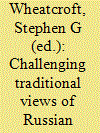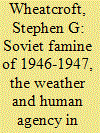| Srl | Item |
| 1 |
ID:
057665


|
|
|
|
|
| Publication |
New York, Palgrave Macmillan, 2002.
|
| Description |
xxi, 242p.: table, figure, maps.Hbk
|
| Series |
Studies in Russian and East European History and Society
|
| Standard Number |
0333754611
|
|
|
|
|
|
|
|
|
|
|
|
Copies: C:1/I:0,R:0,Q:0
Circulation
| Accession# | Call# | Current Location | Status | Policy | Location |
| 046594 | 947/WHE 046594 | Main | On Shelf | General | |
|
|
|
|
| 2 |
ID:
113314


|
|
|
|
|
| Summary/Abstract |
This article considers the famine of the immediate post-war period of 1946-1947 in relation to the food problems experienced by the USSR in World War II and to the impact of the weather conditions from 1941. It is argued that the timing and nature of the extreme food problems experienced in this famine conform to a general pattern of Soviet famines in which urban food supply problems over a number of years give rise to increasing pressure on the peasantry and a general reduction of stocks, which when complicated by drought and harvest failure produces a rural famine.
|
|
|
|
|
|
|
|
|
|
|
|
|
|
|
|
| 3 |
ID:
167555


|
|
|
|
|
| Summary/Abstract |
This essay attempts to understand the history and politics of Soviet grain and demographic statistics, and to show how they were used by the government. It covers the period from Lenin until Stalin’s death. Distortions arose because of over-ambitious planning. Attempts to correct these distortions in 1932 failed because of the cover-up of the famine. Also the results of the census of 1937 were rejected, but the repeat census of 1939 did provide more realistic indicators. For grain, distortions remained to the end of the Stalin period and even increased. The essay argues that the basic statistics available in the archives are reliable and that distortions arose in the reworking of these statistics.
|
|
|
|
|
|
|
|
|
|
|
|
|
|
|
|